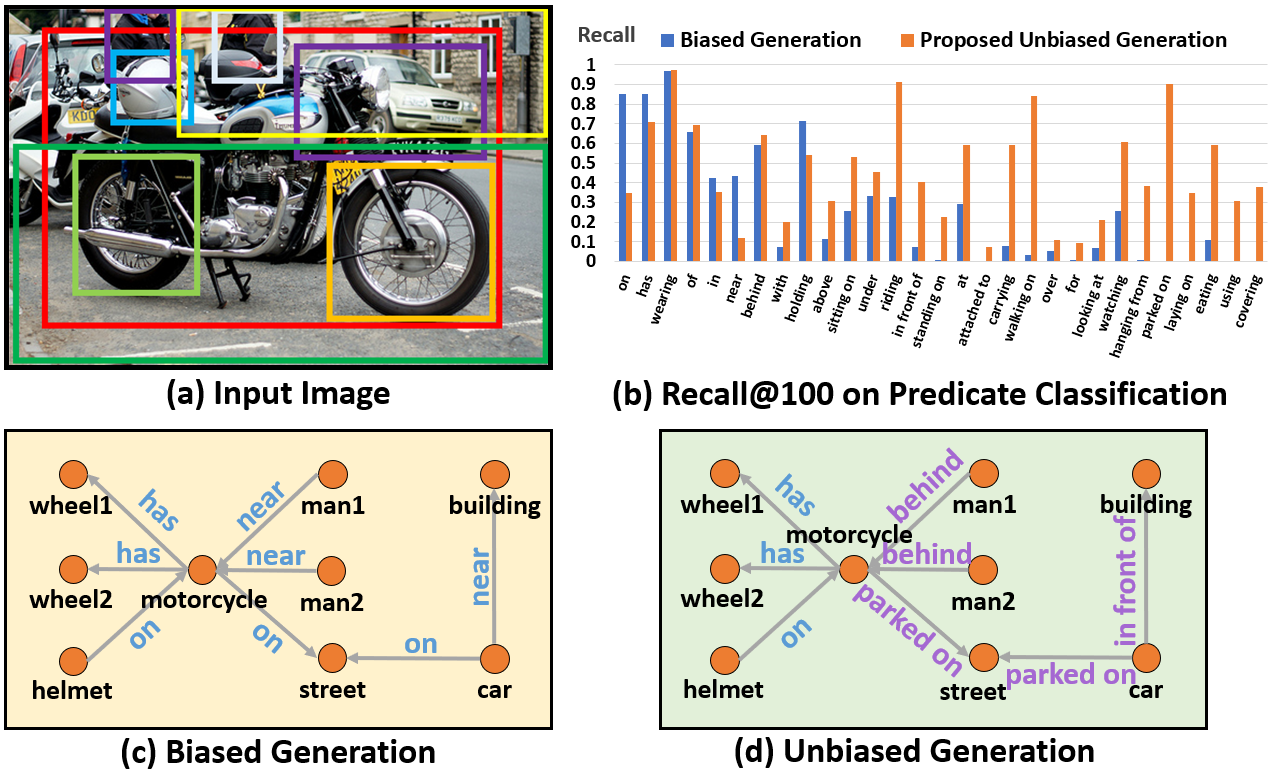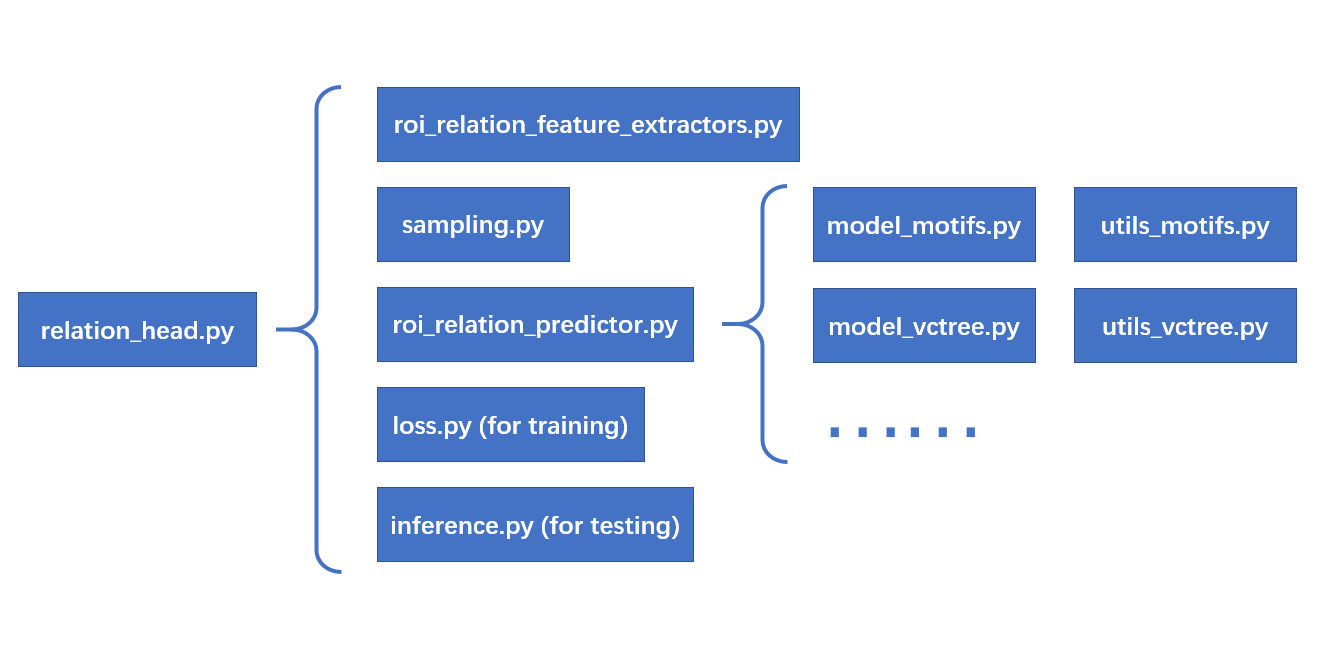Scene Graph Benchmark in Pytorch
Our paper Unbiased Scene Graph Generation from Biased Training has been accepted by CVPR 2020.
Contents
- Overview
- Install the Requirements
- Prepare the Dataset
- Metrics and Results for our Toolkit
- Faster R-CNN Pre-training
- Scene Graph Generation as RoI_Head
- Training on Scene Graph Generation
- Evaluation on Scene Graph Generation
- Other Options that May Improve the SGG
- Tips and Tricks for TDE on any Unbiased Task
- Citations
Overview
This project aims to build a new CODEBASE of Scene Graph Generation (SGG), and it is also a Pytorch implementation of the paper Unbiased Scene Graph Generation from Biased Training. The previous widely adopted SGG codebase neural-motifs is detached from the recent development of Faster/Mask R-CNN. Therefore, I decided to build a scene graph benchmark on top of the well-known maskrcnn-benchmark project and define relationship prediction as an additional roi_head. By the way, thanks to their elegant framework, this codebase is much more novice-friendly and easier to read/modify for your own projects than previous neural-motifs framework(at least I hope so). It is a pity that when I was working on this project, the detectron2 had not been released, but I think we can consider maskrcnn-benchmark as a more stable version with less bugs, hahahaha. I also introduce all the old and new metrics used in SGG, and clarify two common misunderstandings in SGG metrics in METRICS.md, which cause abnormal results in some papers.
Benefit from the up-to-date Faster R-CNN in maskrcnn-benchmark, this codebase achieves new state-of-the-art Recall@k on SGCls & SGGen (by 2020.2.16) through the reimplemented VCTree using two 1080ti GPUs and batch size 8:
| Models | SGGen R@20 | SGGen R@50 | SGGen R@100 | SGCls R@20 | SGCls R@50 | SGCls R@100 | PredCls R@20 | PredCls R@50 | PredCls R@100 |
|---|---|---|---|---|---|---|---|---|---|
| VCTree | 24.53 | 31.93 | 36.21 | 42.77 | 46.67 | 47.64 | 59.02 | 65.42 | 67.18 |
Note that all results of VCTree should be better than what we reported in Unbiased Scene Graph Generation from Biased Training, because we optimized the tree construction network after the publication.
The illustration of the Unbiased SGG from 'Unbiased Scene Graph Generation from Biased Training'
Installation
Check INSTALL.md for installation instructions.
Dataset
Check DATASET.md for instructions of dataset preprocessing.
Metrics and Results (IMPORTANT)
Explanation of metrics in our toolkit and reported results are given in METRICS.md
Pretrained Models
Since we tested many SGG models in our paper Unbiased Scene Graph Generation from Biased Training, I won't upload all the pretrained SGG models here. However, you can download the pretrained Faster R-CNN we used in the paper, which is the most time consuming step in the whole training process (it took 4 2080ti GPUs). As to the SGG model, you can follow the rest instructions to train your own, which only takes 2 GPUs to train each SGG model. The results should be very close to the reported results given in METRICS.md
After you download the Faster R-CNN model, please extract all the files to the directory /home/username/checkpoints/pretrained_faster_rcnn. To train your own Faster R-CNN model, please follow the next section.
Faster R-CNN pre-training
The following command can be used to train your own Faster R-CNN model:
CUDA_VISIBLE_DEVICES=0,1,2,3 python -m torch.distributed.launch --master_port 10001 --nproc_per_node=4 tools/detector_pretrain_net.py --config-file "configs/e2e_relation_detector_X_101_32_8_FPN_1x.yaml" SOLVER.IMS_PER_BATCH 8 TEST.IMS_PER_BATCH 4 DTYPE "float16" SOLVER.MAX_ITER 50000 SOLVER.STEPS "(30000, 45000)" SOLVER.VAL_PERIOD 2000 SOLVER.CHECKPOINT_PERIOD 2000 MODEL.RELATION_ON False OUTPUT_DIR /home/kaihua/checkpoints/pretrained_faster_rcnn SOLVER.PRE_VAL Falsewhere CUDA_VISIBLE_DEVICES and --nproc_per_node represent the id of GPUs and number of GPUs you use, --config-file means the config we use, where you can change other parameters. SOLVER.IMS_PER_BATCH and TEST.IMS_PER_BATCH are the training and testing batch size respectively, DTYPE "float16" enables Automatic Mixed Precision supported by APEX, SOLVER.MAX_ITER is the maximum iteration, SOLVER.STEPS is the steps where we decay the learning rate, SOLVER.VAL_PERIOD and SOLVER.CHECKPOINT_PERIOD are the periods of conducting val and saving checkpoint, MODEL.RELATION_ON means turning on the relationship head or not (since this is the pretraining phase for Faster R-CNN only, we turn off the relationship head), OUTPUT_DIR is the output directory to save checkpoints and log (considering /home/username/checkpoints/pretrained_faster_rcnn), SOLVER.PRE_VAL means whether we conduct validation before training or not.
Scene Graph Generation as RoI_Head
To standardize the SGG, I define scene graph generation as an RoI_Head. Referring to the design of other roi_heads like box_head, I put most of the SGG codes under maskrcnn_benchmark/modeling/roi_heads/relation_head and their calling sequence is as follows:
Perform training on Scene Graph Generation
There are three standard protocols: (1) Predicate Classification (PredCls): taking ground truth bounding boxes and labels as inputs, (2) Scene Graph Classification (SGCls) : using ground truth bounding boxes without labels, (3) Scene Graph Detection (SGDet): detecting SGs from scratch. We use two switches MODEL.ROI_RELATION_HEAD.USE_GT_BOX and MODEL.ROI_RELATION_HEAD.USE_GT_OBJECT_LABEL to select the protocols.
For Predicate Classification (PredCls), we need to set:
MODEL.ROI_RELATION_HEAD.USE_GT_BOX True MODEL.ROI_RELATION_HEAD.USE_GT_OBJECT_LABEL TrueFor Scene Graph Classification (SGCls):
MODEL.ROI_RELATION_HEAD.USE_GT_BOX True MODEL.ROI_RELATION_HEAD.USE_GT_OBJECT_LABEL FalseFor Scene Graph Detection (SGDet):
MODEL.ROI_RELATION_HEAD.USE_GT_BOX False MODEL.ROI_RELATION_HEAD.USE_GT_OBJECT_LABEL FalsePredefined Models
We abstract various SGG models to be different relation-head predictors in the file roi_heads/relation_head/roi_relation_predictors.py, which are independent of the Faster R-CNN backbone and relation-head feature extractor. To select our predefined models, you can use MODEL.ROI_RELATION_HEAD.PREDICTOR.
For Neural-MOTIFS Model:
MODEL.ROI_RELATION_HEAD.PREDICTOR MotifPredictorFor Iterative-Message-Passing(IMP) Model (Note that SOLVER.BASE_LR should be changed to 0.001 in SGCls, or the model won't converge):
MODEL.ROI_RELATION_HEAD.PREDICTOR IMPPredictorFor VCTree Model:
MODEL.ROI_RELATION_HEAD.PREDICTOR VCTreePredictorFor our predefined Transformer Model (Note that Transformer Model needs to change SOLVER.BASE_LR to 0.001), which is provided by Jiaxin Shi:
MODEL.ROI_RELATION_HEAD.PREDICTOR TransformerPredictorFor Unbiased-Causal-TDE Model:
MODEL.ROI_RELATION_HEAD.PREDICTOR CausalAnalysisPredictorThe default settings are under configs/e2e_relation_X_101_32_8_FPN_1x.yaml and maskrcnn_benchmark/config/defaults.py. The priority is command > yaml > defaults.py
Customize Your Own Model
If you want to customize your own model, you can refer maskrcnn-benchmark/modeling/roi_heads/relation_head/model_XXXXX.py and maskrcnn-benchmark/modeling/roi_heads/relation_head/utils_XXXXX.py. You also need to add corresponding nn.Module in maskrcnn-benchmark/modeling/roi_heads/relation_head/roi_relation_predictors.py. Sometimes you may also need to change the inputs & outputs of the module through maskrcnn-benchmark/modeling/roi_heads/relation_head/relation_head.py.
The proposed Causal TDE on Unbiased Scene Graph Generation from Biased Training
As to the Unbiased-Causal-TDE, there are some additional parameters you need to know. MODEL.ROI_RELATION_HEAD.CAUSAL.EFFECT_TYPE is used to select the causal effect analysis type during inference(test), where "none" is original likelihood, "TDE" is total direct effect, "NIE" is natural indirect effect, "TE" is total effect. MODEL.ROI_RELATION_HEAD.CAUSAL.FUSION_TYPE has two choice "sum" or "gate". Since Unbiased Causal TDE Analysis is model-agnostic, we support Neural-MOTIFS, VCTree and VTransE. MODEL.ROI_RELATION_HEAD.CAUSAL.CONTEXT_LAYER is used to select these models for Unbiased Causal Analysis, which has three choices: motifs, vctree, vtranse.
Note that during training, we always set MODEL.ROI_RELATION_HEAD.CAUSAL.EFFECT_TYPE to be 'none', because causal effect analysis is only applicable to the inference/test phase.
Examples of the Training Command
Training Example 1 : (PreCls, Motif Model)
CUDA_VISIBLE_DEVICES=0,1 python -m torch.distributed.launch --master_port 10025 --nproc_per_node=2 tools/relation_train_net.py --config-file "configs/e2e_relation_X_101_32_8_FPN_1x.yaml" MODEL.ROI_RELATION_HEAD.USE_GT_BOX True MODEL.ROI_RELATION_HEAD.USE_GT_OBJECT_LABEL True MODEL.ROI_RELATION_HEAD.PREDICTOR MotifPredictor SOLVER.IMS_PER_BATCH 12 TEST.IMS_PER_BATCH 2 DTYPE "float16" SOLVER.MAX_ITER 50000 SOLVER.VAL_PERIOD 2000 SOLVER.CHECKPOINT_PERIOD 2000 GLOVE_DIR /home/kaihua/glove MODEL.PRETRAINED_DETECTOR_CKPT /home/kaihua/checkpoints/pretrained_faster_rcnn/model_final.pth OUTPUT_DIR /home/kaihua/checkpoints/motif-precls-exmpwhere GLOVE_DIR is the directory used to save glove initializations, MODEL.PRETRAINED_DETECTOR_CKPT is the pretrained Faster R-CNN model you want to load, OUTPUT_DIR is the output directory used to save checkpoints and the log. Since we use the WarmupReduceLROnPlateau as the learning scheduler for SGG, SOLVER.STEPS is not required anymore.
Training Example 2 : (SGCls, Causal, TDE, SUM Fusion, MOTIFS Model)
CUDA_VISIBLE_DEVICES=0,1 python -m torch.distributed.launch --master_port 10026 --nproc_per_node=2 tools/relation_train_net.py --config-file "configs/e2e_relation_X_101_32_8_FPN_1x.yaml" MODEL.ROI_RELATION_HEAD.USE_GT_BOX True MODEL.ROI_RELATION_HEAD.USE_GT_OBJECT_LABEL False MODEL.ROI_RELATION_HEAD.PREDICTOR CausalAnalysisPredictor MODEL.ROI_RELATION_HEAD.CAUSAL.EFFECT_TYPE none MODEL.ROI_RELATION_HEAD.CAUSAL.FUSION_TYPE sum MODEL.ROI_RELATION_HEAD.CAUSAL.CONTEXT_LAYER motifs SOLVER.IMS_PER_BATCH 12 TEST.IMS_PER_BATCH 2 DTYPE "float16" SOLVER.MAX_ITER 50000 SOLVER.VAL_PERIOD 2000 SOLVER.CHECKPOINT_PERIOD 2000 GLOVE_DIR /home/kaihua/glove MODEL.PRETRAINED_DETECTOR_CKPT /home/kaihua/checkpoints/pretrained_faster_rcnn/model_final.pth OUTPUT_DIR /home/kaihua/checkpoints/causal-motifs-sgcls-exmpEvaluation
Examples of the Test Command
Test Example 1 : (PreCls, Motif Model)
CUDA_VISIBLE_DEVICES=0 python -m torch.distributed.launch --master_port 10027 --nproc_per_node=1 tools/relation_test_net.py --config-file "configs/e2e_relation_X_101_32_8_FPN_1x.yaml" MODEL.ROI_RELATION_HEAD.USE_GT_BOX True MODEL.ROI_RELATION_HEAD.USE_GT_OBJECT_LABEL True MODEL.ROI_RELATION_HEAD.PREDICTOR MotifPredictor TEST.IMS_PER_BATCH 1 DTYPE "float16" GLOVE_DIR /home/kaihua/glove MODEL.PRETRAINED_DETECTOR_CKPT /home/kaihua/checkpoints/motif-precls-exmp OUTPUT_DIR /home/kaihua/checkpoints/motif-precls-exmpTest Example 2 : (SGCls, Causal, TDE, SUM Fusion, MOTIFS Model)
CUDA_VISIBLE_DEVICES=0 python -m torch.distributed.launch --master_port 10028 --nproc_per_node=1 tools/relation_test_net.py --config-file "configs/e2e_relation_X_101_32_8_FPN_1x.yaml" MODEL.ROI_RELATION_HEAD.USE_GT_BOX True MODEL.ROI_RELATION_HEAD.USE_GT_OBJECT_LABEL False MODEL.ROI_RELATION_HEAD.PREDICTOR CausalAnalysisPredictor MODEL.ROI_RELATION_HEAD.CAUSAL.EFFECT_TYPE TDE MODEL.ROI_RELATION_HEAD.CAUSAL.FUSION_TYPE sum MODEL.ROI_RELATION_HEAD.CAUSAL.CONTEXT_LAYER motifs TEST.IMS_PER_BATCH 1 DTYPE "float16" GLOVE_DIR /home/kaihua/glove MODEL.PRETRAINED_DETECTOR_CKPT /home/kaihua/checkpoints/causal-motifs-sgcls-exmp OUTPUT_DIR /home/kaihua/checkpoints/causal-motifs-sgcls-exmpOther Options that May Improve the SGG
-
For some models (not all), turning on or turning off
MODEL.ROI_RELATION_HEAD.POOLING_ALL_LEVELSwill affect the performance of predicate prediction, e.g., turning it off will improve VCTree PredCls but not the corresponding SGCls and SGGen. For the reported results of VCTree, we simply turn it on for all three protocols like other models. -
For some models (not all), a crazy fusion proposed by Learning to Count Object will significantly improves the results, which looks like
f(x1, x2) = ReLU(x1 + x2) - (x1 - x2)**2. It can be used to combine the subject and object features inroi_heads/relation_head/roi_relation_predictors.py. For now, most of our model just concatenate them astorch.cat((head_rep, tail_rep), dim=-1). -
Not to mention the hidden dimensions in the models, e.g.,
MODEL.ROI_RELATION_HEAD.CONTEXT_HIDDEN_DIM. Due to the limited time, we didn't fully explore all the settings in this project, I won't be surprised if you improve our results by simply changing one of our hyper-parameters
Tips and Tricks for any Unbiased TaskX from Biased Training
The proposed unbiased counterfactual inference in our paper Unbiased Scene Graph Generation from Biased Training is not only applicable to SGG. Actually, the similar idea WORKS AS WELL in other tasks when I worked with Yulei (The code will be released on his github upon acceptance). We believe such an counterfactual inference can also be applied to lots of reasoning tasks with significant bias. It basically just runs the model two times (one for original output, another for the intervened output), and the later one gets the biased prior that should be subtracted from the final prediction. But there are three tips you need to bear in mind:
- The most important things is always the causal graph. You need to find the correct causal graph with an identifiable branch that causes the biased predictions. If the causal graph is incorrect, the rest would be meaningless. Note that causal graph is not the summarization of the existing network (but the guidance to build networks), you should modify your network based on causal graph, but not vise versa.
- For those nodes having multiple input branches in the causal graph, it's crucial to choose the right fusion function. We tested lots of fusion funtions and only found the SUM fusion and GATE fusion consistently working well. The fusion function like element-wise production won't work for TDE analysis in most of the cases, because the causal influence from multiple branches can not be linearly/monotonously separated anymore, i.e., its no longer an identifiable 'influence'.
- For those final predictions having multiple input branches in the causal graph, it may also need to add auxiliary losses for each branch to stablize the causal influence of each independent branch. Because when these branches have different convergent speeds, those hard branches would easily be learned as unimportant tiny floatings that depend on the fastest converged branch, i.e., different branches should have approximately independent influences.
If you think about our advice, you may realize that the only rule is to maintain the independent causal influence from each branch to the target node as stable as possible, and use the causal influence fusion functions that are explicit and explainable. It's probably because the causal effect is very human-centric/subjective/recognizable (sorry, I don't know which word I should use here to express my intuition.), so those unexplainable fusion functions and implicit combined single loss (without auxiliary losses when multiple branches are involved) will mess up influences with different sources.
To Do List
- Reorganize Code and Instructions of S2G Retrieval
- Publish Visualization Tool for SGG
Citations
If you find this project helps your research, please kindly consider citing our papers in your publications.
@inproceedings{tang2018learning,
title={Learning to Compose Dynamic Tree Structures for Visual Contexts},
author={Tang, Kaihua and Zhang, Hanwang and Wu, Baoyuan and Luo, Wenhan and Liu, Wei},
booktitle= "Conference on Computer Vision and Pattern Recognition",
year={2019}
}
@article{tang2020unbiased,
title={Unbiased Scene Graph Generation from Biased Training},
author={Tang, Kaihua and Niu, Yulei and Huang, Jianqiang and Shi, Jiaxin and Zhang, Hanwang},
journal={arXiv preprint arXiv:2002.11949},
year={2020}
}




